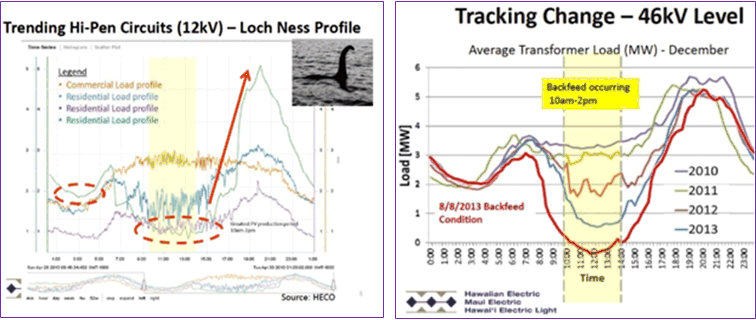3.5 Examples of DER Grid Codes for Advanced Functions
3.5.3 Hawaiian Grid Codes
Hawaiian Electric (HECO) on Oahu was required to slow down the installations of new PV systems due to concerns that more solar could cause voltage problems in some neighborhoods. In 2013, about 300 megawatts of rooftop solar were interconnected at 40,000 locations, comprising around 10 percent of its customers. In some neighborhoods, PV systems were generating more than the utility's daytime minimum load causing back-feed and were also creating over-voltage problems on these feeders.
This situation is giving rise to the “Lock Ness Monster Curve ” which is similar but more exaggerated than CAISO’s Duck Curve. In this diagram, there is back feed from one feeder to another feeder, causing a mid-day sag in residential energy demand, as rooftop solar PV energy supply exceeds the energy demand on those circuits, then the steep curve upward as solar fades away and late afternoon demand increases.

Figure 14: Hawaii’s Loch Ness Curve showing back feed through substations to other feeders
The electric system in Hawaii upstream of distribution and subtransmission substations is significantly different than for utilities in WECC due to the isolated island location. Lack of access to a broader grid can cause system impacts in Hawaii that require a modified set of solutions than would be applicable on the mainland. In Hawaii, reverse flow from distribution circuits that serves other feeders or even the higher voltage network requires a change in dispatch of the HECO generation portfolio. HECO is exploring more flexible generation options as a possible mitigation strategy for the afternoon “loch ness curve.”
High PV penetration on many of HECO’s feeders has exceeded acceptable levels, which were initially set at 75% of daytime minimum load for projects under 10 kW. This level has since been raised to 120% of daytime minimum load (DML) for projects under 10 kW. This level was raised to 120% of DML, but HECO still was under pressure to increase this level. HECO cites two primary concerns preventing PV penetration higher than 120% of DML:
-
Transient over voltage spikes
-
Headroom on circuit to accommodate switching actions or contingency situations
Inverter manufacturers have been working with HECO to ensure that their inverters “cease to energize” during ride-through of large transient voltage spikes to ensure that voltages never reach excessive levels which might damage utility and customer equipment. These ride-through requirements are based on California’s Smart Inverter Working Group (SIWG) functions.
HECO subsequently sponsored a project with NREL and Solar City to test inverter functions and reliability during transient overvoltage events. Based on the results of these tests, HECO announced in a January 20, 2015 filing with the Hawaii Public Utilities Commission that it intends to increase its penetration limits for rooftop solar from the current limit of 120% of DML to 250% of DML. These results may have much broader implications for other utilities even though they were carried out for island conditions. .
Ensuring that excess capacity is still maintained within the thermal limit of the feeder to transfer power will require more advanced scenario-based planning and interconnection study processes.
Dora Nakafuji, director of renewable energy planning for Hawaii Electric Co. (HECO) presentation at Distributech, 2014
http://www.renewableenergyworld.com/rea/news/article/2014/02/the-interconnection-nightmare-in-hawaii-and-why-it-matters-to-the-u-s-residential-pv-industry
http://www.renewableenergyworld.com/rea/news/article/2014/02/the-interconnection-nightmare-in-hawaii-and-why-it-matters-to-the-u-s-residential-pv-industry
http://files.hawaii.gov/puc/4_Book%201%20%28transmittal%20ltr_DGIP_Attachments%20A-1%20to%20A-5%29.pdf